Pros
Cons
Introduction
Front
{{section_header}}{{section.name}}{{/section_header}}

Back
{{section_header}}{{section.name}}{{/section_header}}

Sides
{{section_header}}{{section.name}}{{/section_header}}

Top
{{section_header}}{{section.name}}{{/section_header}}

Bottom
{{section_header}}{{section.name}}{{/section_header}}

In the Box
{{section_header}}{{section.name}}{{/section_header}}

In the box:
• Olympus SP-810UZ digital camera
• lens cap with strap
• neck strap
• A/V cable
• USB cable
• AC wall socket power adapter
• instruction manual
• software CD-ROM
Color
{{section_header}}{{section.name}}{{/section_header}}
The SP-810UZ's reproduction of color is good but not great. We recorded an error value of 3.16 in our test, and 3.00 flat is average (lower scores are better). The most inaccurate shades, unfortunately, are those found in skin. Bright yellows are too dark, while reds are too close to brown. As a result, human subjects won't appear as flattering as they would with a more expensive, more accurate model. Blues are also a problem, with all tints darker than they should be. More on how we test color.
Since the ultrazoom market is fairly crowded, we'll be performing comparisons based mainly on price range. Unfortunately for our SP-810UZ, one close competitor is the Panasonic Lumix FZ47, which currently holds the title for the most color-accurate camera we've ever tested. This isn't to say the Olympus lags completely behind though, Nikon's P500 is far less accurate than the SP-810UZ.
Color Modes
{{section_header}}{{section.name}}{{/section_header}}
The SP-810UZ is not configured to shoot with individual color modes. We prefer it this way, since we always test for the most accurate one and shoot with it from then on. Still, the omission leaves us no points to award here.
Noise
{{section_header}}{{section.name}}{{/section_header}}
Although noise scores are relatively high, a cursory glance at real-world images captured by this camera reveals a destructive and ugly noise reduction package. What's happened here is the SP-810UZ has used smudging to fool our test. In the face crops below, note the difference between the Olympus and the Nikon, whose scores were almost identical. Nikon's P500 is prone to haloing but maintains a clean edge until ISO 800, while the SP-810UZ shots are blurred as early as ISO 200. The majority of noise comes from luminance artifacts, so images are more grainy and less polluted by specks of color. More on how we test noise.
As far as our testing software is concerned, results are almost identical in low light, with an average noise increase of only 0.06%. Yet the experience is quite different in practice. The camera's somewhat narrow maximum aperture and fast maximum shutter speed make gathering light difficult. We had to increase our studio illumination to 75 lux (60 lux is standard) in order to achieve a proper exposure. So although low light performance seems equal by numbers, you'll end up having to use a more sensitive ISO to get the same results, at the expensive of image quality.
Despite our opinions, the scores themselves are among the best in this price range. Fujifilm's FinePix HS20EXR lags way behind, while the Panasonic FZ47 is close, but not close enough.
{{comparison_bars title="Noise Score Comparison", attribute="Noise Score", xLabel="Noise Score"}}
ISO
{{section_header}}{{section.name}}{{/section_header}}
The ISO range starts off at 64, and this is really the only setting that can reliably produce clean images. Maximum ISO is 1600, and while we sometimes see 3200 or even 6400 at this price range, with 1600 looking the way it does with this camera, we're not surprised to see extended settings left out.
NOTE: The images above are not used in our testing or scoring, but are included here to show real-world examples of the differences between cameras at the various ISO settings.
Resolution
{{section_header}}{{section.name}}{{/section_header}}
Our resolution score is a weighted average of a given camera's distortion, sharpness, and chromatic aberration, which together provide an overview of the lens' quality. In this regard, the SP-810UZ excels, posting the best score of our comparison group, just a hair in front of the FZ47. Olympus makes solid lenses in general, and their expertise is obvious here. More on how we test resolution.
Distortion ({{product.raw_scores['Distortion Score']}})
Image distortion is relatively minor, with just under 1% barrel and pincushion distortion at the widest and middle focal lengths respectively. At maximum zoom, that figure drops down to only -0.06%.
Sharpness ({{product.raw_scores['Sharpness Score']}})
So long as your ISO is set to minimum, the SP-810UZ offers the best detail of this comparison group. Average detail can approach 2200 MTF50s at the the center of the frame, though this drops off by about 25% as we approach the edge. Detail also drops as focal length increases, first to 2100 MTF50s midway, then 1800 at the longest zoom. Detail loss at the edge of the frame is also much more severe at full 36x zoom, quickly dropping down to an average of 1200 MTF50s.
Chromatic Aberration ({{product.raw_scores['Chromatic Aberration Score']}})
Our test detected only minor to moderate chromatic aberration while shooting the test chart, and we're happy to report the problem is virtually absent in real world shooting as well. Most edges are free of chromatic aberration entirely, with only a bit of blue or yellow fringing at the extreme edges of the frame.
Quality & Size Options
{{section_header}}{{section.name}}{{/section_header}}
4:3 and 16:9 are the only aspect ratios supported, but there's a decent selection of resolutions at least. Seven 4:3 choices and two 16:9 settings are available, with Fine or Normal compression quality levels for each. The SP-810UZ does not support lossless RAW encoding.
Image Stabilization
{{section_header}}{{section.name}}{{/section_header}}
Olympus' sensor-shift image stabilization is very effective here. In our shaker test, image detail shot up by 39% with the stabilizer active. In fairness, detail was fairly low to begin with, since vibrations are compounded by zoom, but the results are impressive nonetheless. More on how we test image stabilization.
Olympus' only competition here is from the Fujifilm HS20EXR, which is equipped with an even more effective stabilizer. The FZ47's stabilizer actually worsens detail by 7%, while the P500's makes little difference.
{{comparison_bars title="Stabilization Score Comparison", attribute="Stabilization Score", xLabel="Stabilization Score"}}
Video Mode
{{section_header}}{{section.name}}{{/section_header}}
Video shooting with the SP-810UZ is limited. Resolution maxes out at 720p, and frame rate seems to be locked at 30 (though we could find no documentation to confirm this). Control access is nonexistent while recording, optical zoom and all the menus are locked. Autofocus–at least–is active, though the contrast-based system is aggressive and sometimes distracting. In fact, the effect is noticeable in the motion test below.
Video Color
{{section_header}}{{section.name}}{{/section_header}}
Color accuracy plummets while shooting video, and while this is fairly common, the problem is worse here than in some of the competition. The vast majority of colors are too dark, though saturation is pretty close. More on how we test video color.
{{comparison_bars title="Video Color Score Comparison", attribute="Video Color Score", xLabel="Video Color Score"}}
Video Sharpness
{{section_header}}{{section.name}}{{/section_header}}
Sharpness also tends to dip while shooting video, and again the problem is more severe in the SP-810UZ. The camera resolves 450 lw/ph of detail horizontally and 500 vertically, less than the FZ47 and P500, but more than the HS20EXR. More on how we test video sharpness.
{{comparison_bars title="Video Color Sharpness Comparison", attribute="Video Sharpness Score", xLabel="Video Sharpness Score"}}
Playback Mode
{{section_header}}{{section.name}}{{/section_header}}
Playback mode is pretty typical. Fullscreen display with zoom and shooting information, grid display of varying proportions; calendar mode is missed, but isn't a deal-breaker. The interface itself is intuitive, operated via a combination of the zoom lever and rotating directional pad, but processing speed is slow, often necessitating half-second pauses.
In-Camera Editing
{{section_header}}{{section.name}}{{/section_header}}
The most useful in-camera editing function is Beauty Fix, which smooths skin, or adds sparkle or shadow to the eye, or all three. Check out the shots of a handsome camera critic below to see this in action. Other basic functions are also possible, including resize, crop, voice memo, shadow adjustment, and red-eye correction.
Direct Print Options
{{section_header}}{{section.name}}{{/section_header}}
DPOF tagging is possible either individually or all at once, with support for up to 10 copies each. The interface is too simple, with no easy way to skip through large sections of photos. Functionality like this could've easily been mapped to the zoom lever, but isn't.
Display
{{section_header}}{{section.name}}{{/section_header}}
The three inch, 16:9 LCD is your only means of framing in the absence of a viewfinder. Olympus was forced to make this major concession in order to squeeze the ultrazoom lens onto a smaller frame. The LCD is bright enough, and the 460,000-dot resolution is fine, but viewing angle is limited and the onscreen display isn't legible from far away. An EVF is sorely missed.

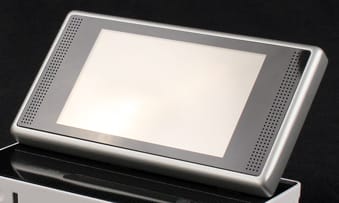
...but it turns into a nice 3-inch widescreen in playback mode.
Flash
{{section_header}}{{section.name}}{{/section_header}}
The SP-810UZ's flash enclosure is not automated in anyway, and must be physically lifted into place before use. It's a cheap, lackluster way of getting the job done, and doesn't impart that pro-photographer feel at all. Effective flash range is average and, aside from basic red-eye reduction, no advanced features such as slow synchro are included.

The flash emitter pops up from the top of the body via a mechanical release.
Lens
{{section_header}}{{section.name}}{{/section_header}}
The plastic lens barrel extends from the main body regardless of focal length, and zoom action is rather ponderous due to a weak, noisy motor. Surrounding the opening is a chrome bezel, so shiny that it often reflects light directly onto your subject. At least the bezel looks nice, the barrel itself is plain black matte.

Optical zoom range extends all the way to 36x, making this camera's reach one of the longest we've seen all year. This is just a crazy amount of zoom, more than enough to scope all the way across a football field or, as seen in the crops below, across the street and into your neighbor's window...if that's your thing.
Battery
{{section_header}}{{section.name}}{{/section_header}}
The included LI-50B battery is CIPA rated at 190 shots, placing it at the lower end of the ultrazoom spectrum. Our experience with the camera confirmed this, the battery was quick to discharge. Conveniently however, the battery is always charged with USB, using either the AC wall socket adapter, or by simply plugging the camera into a computer. Playback mode is also unlocked while charging.

Memory
{{section_header}}{{section.name}}{{/section_header}}
The SP-810UZ is compatible with SD, SDHC, and fast SDXC memory cards, as well as Eye-Fi cards for wireless connectivity. In a pinch, some internal memory is available, but only enough for two full resolution pictures.

Jacks, Ports & Plugs
{{section_header}}{{section.name}}{{/section_header}}
Both terminals are housed underneath a plastic cover on the right side of the body. A proprietary USB port is responsible for both battery charging and most data output. There's also a micro-HDMI port for streaming photos or videos to an HDTV.
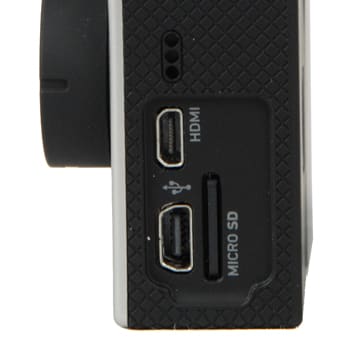
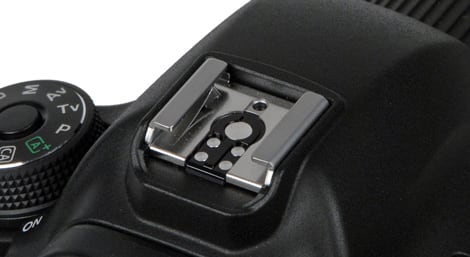
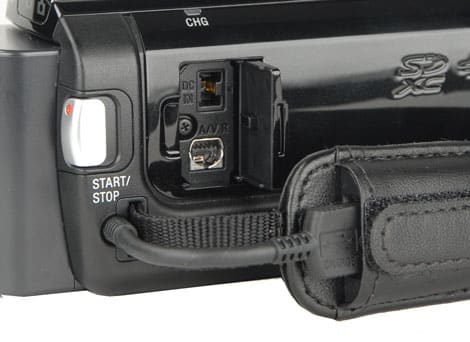
The DC-input and multi-AV port are located on the right side of the camcorder.
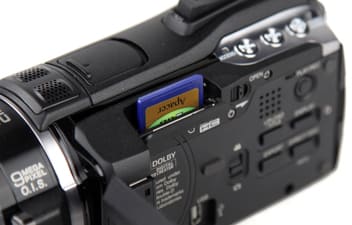
... as is the SD/SDHC card slot.
Shooting Modes
{{section_header}}{{section.name}}{{/section_header}}
The camera defaults to Program shooting mode and that's where we left it. There's also an Intelligent Auto mode, Scene mode, Magic Effect mode, dedicated panorama mode, and 3D photography mode. The SP-810UZ is not equipped with a hardware mode dial, but shooting modes are easily accessible from the first option on the quick menu.

The full mode dial is nice, but frequently rotates by accident.
Scene Modes
16 scene mode settings are available and they're relatively mundane. A few are useful, such as Fireworks or Night Portrait, which unlock shutter speeds above a half second. Two pet modes, one for cats and one for dogs, always seem ridiculous to us, but the right customer could fall in love with the option.
Picture Effects
{{section_header}}{{section.name}}{{/section_header}}
We typically regard picture effects as little more than a fun diversion, but the SP-810UZ's are actually really cool. Many effects are drastic and convincing, such as Drawing or Watercolor. For examples of all 10 effects, use the widget below.
Manual Controls
{{section_header}}{{section.name}}{{/section_header}}
Mechanical manual controls are absent from the SP-810UZ, and manual control is limited in software too. There's no program shift, and thus no ability to tweak aperture or shutter speed. This wouldn't be so much of a problem if the camera's metering wasn't so quirky, we found ourselves constantly wishing for more detailed control. At least ISO and white balance can be selected manually.
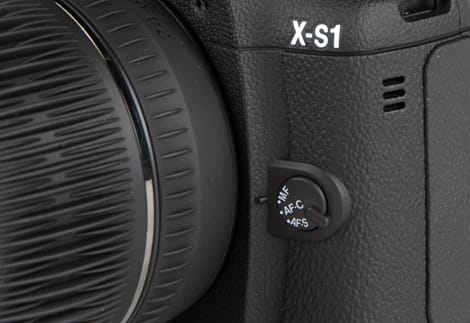
A dedicated focus-mode switch on the front panel.
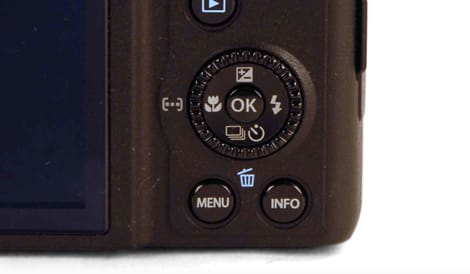
The scroll wheel surrounding the d-pad is neither awful nor perfect.
Drive/Burst Mode
{{section_header}}{{section.name}}{{/section_header}}
Although self-timer settings are limited to only 12-second and 2-second varieties, the camera's drive mode is decent otherwise. A full resolution burst is supported (though the capacity varies unpredictably between four and seven shots), as well as three faster speeds at the expense of resolution.
Shot to Shot ({{product.raw_scores['Shot to Shot Score']}})
At full resolution, the SP-810UZ can manage only 0.88 frames per second on average, quite a bit lower than all of our comparison cameras. High-speed, reduced resolution burst modes are a different story though, maxing out just shy of 30 frames per second.
Handling
{{section_header}}{{section.name}}{{/section_header}}
Although the right hand grip is rubberized, the protrusion is neither sufficiently deep nor wide, resulting in a thin handle that doesn't fit comfortably in the average hand. This also places the shutter release far out of reach, necessitating an even less comfortable, less stable grip.

Things are even worse around back. The cheap, plastic rear panel provides little grip or leverage, despite a thumb rest at the top right corner. We recommend two-handed shooting for this camera.



These dedicated buttons give you quick access to aperture and shutter speed controls.
Buttons & Dials
{{section_header}}{{section.name}}{{/section_header}}
The poorly designed rear control panel is confusing for newcomers. The upper playback button is symmetrical with an identically shaped button below the control dial, except this lower button performs two functions: menu access and in-camera help. Since the menu button is so important, it's strange to map this function to only half a button. Above the playback key, the video button is recessed into the body, and requires a fingernail to press.

On the top panel, the on / off button is located in a good spot, but the quality of the shutter release is strictly average. Some tactile response is there, but we always prefer a long stroke, and this button has barely any. Interestingly, the small plastic "mound" on which the shutter release rests, has actually been angled slightly to the left. This may have been designed to aid with–or encourage–the claw grip this camera requires.

Menus
{{section_header}}{{section.name}}{{/section_header}}
The SP-810UZ's quick menu is, in a sense, always active. Simply pressing down on the directional pad begins menu navigation, and the interface is relatively fast and intuitive, though we wish settings were a little more legible and that the menu remembered your previous place.
Beyond that, the main menu is accessed by either pressing the "menu" half of the bottom key, or navigating to the last option in the quick menu. This tabbed interface is slower than others, since it makes no use of the zoom lever, but still better than many other options currently on the market.
Manual & Learning
{{section_header}}{{section.name}}{{/section_header}}
The SP-810UZ ships with a basic user's guide that's fairly unhelpful. A more detailed manual is available online, but it seems incomplete. To our amusement, a few annotations have been accidentally included in the live version. Little notes like "not sure why this is here," for example. Presumably, Olympus published a version that was in the final stages of editing. This should be fixed once the camera has been out for awhile, and we hope they'll add more helpful specs and detail too.
Fujifilm FinePix HS20EXR Comparison
Panasonic's FZ47 is one of the finest fixed-lens cameras we've ever tested and remains one of the best values out there. We've yet to encounter an ultrazoom with better color accuracy, and this test is what chiefly distinguishes the FZ47 from the Olympus SP-810UZ, and most other cameras for that matter. The FZ47 also offers much better burst shooting, an electronic viewfinder, more comfortable handling, and shoots cleaner photos overall.
On the other hand, the FZ47 is only a 24x model, and some consumers will be turned off by that. We often argue that most users require far less zoom than they think. Still, if 36x is absolutely essential to you, the SP-810UZ at least retains a fighting chance in this comparison.
Nikon Coolpix P500 Comparison
We have great respect for Fujifilm's HS10 and HS20EXR, both of which implemented a mechanical zoom ring, rare in this category. The design of the lens caused problems however. Sharpness took a major hit, and chromatic aberration polluted many images. Aside from this, the HS20EXR is a great camera, better in fact–according to overall score–than the SP-810UZ. But with resolution being a primary advantage of the SP-810UZ, it's hard to ignore this glaring difference, in spite of scores.
We expect this choice will come down to personal preference, Olympus' small form factor versus Fujifilm's handicapped lens.
COMP 3
Of the four models compared today, Nikon's excellent P500 is actually in third place, just behind the HS20EXR and ahead of our SP-810UZ. But if this were purely about scores, well there wouldn't be very much use for writers like us. The truth is, despite our numbers, the P500 takes the most appealing photos of the entire lot, and we easily recommend it over the SP-810UZ.
With the P500, details are clean and sharp up through ISO 800, something the SP-810UZ is barely capable of at ISO 200. Nikon's camera is also geared strongly toward the enthusiast, with precise, transparent controls and many advanced shooting features. The difference between these two is night and day.
Conclusion
For us, innovation is always welcome in the saturated ultrazoom market. Olympus' SP series deserves credit here for trying something different. Their goal is to fit the same capabilities of a clunky superzoom camera into a smaller, more portable body. Olympus is known for their excellent compact system cameras, so an ultrazoom design with similar shape and size makes sense for the company's brand and style. Their SP lineup has carried on in this manner since 2005.
But the problem–we think–with this series, is that in the six years since, only one particular feature has been paid much attention. Optical zoom has skyrocketed since the SP-500 debuted with only 10x, and in a trend that mirrors the industry at large, image quality seems to have suffered for it.
The SP-810UZ's color accuracy was disappointing, but its noisy, blurred images–even at low ISOs–is absolutely inexcusable. Unless you plan to shoot exclusively in broad daylight, this camera's small form factor is not worth the compromise in image clarity. For clean shots in any lighting situation, Nikon's P500 is one of many better choices.
On the other hand, Olympus' lens is remarkably well crafted. Edges are razor-sharp, chromatic aberration is all but absent, and distortion is under control. It is utterly tragic that a lens of this caliber has been wasted on a sensor that seems incapable of rendering an appealing photo.
In the end, the SP series' latest is a proof of concept for this lens and this body design, and we're looking forward to a future CMOS-based model. But in the meantime, we don't recommend purchasing the SP-810UZ.
Photo Gallery
{{photo_gallery "Front Photo", "Back Photo", "Sides Photo", "Top Photo", "Bottom Photo", "Lens Photo", "Flash Photo", "EVF Photo 1", "EVF Photo 2", "LCD Photo 1", "LCD Photo 2", "Media Photo", "Modes Photo", "Manual Controls Photo", "Manual Controls Photo 2", "Other Controls", "Buttons 1", "Buttons 2", "Other Hardware Photo", "Battery Photo", "Ports Photo 1", "Ports Photo 2", "Ports Photo 3", "Ports Photo 4", "Handling Photo 1", "Handling Photo 2", "Handling Photo 3", "Box Photo"}}
Meet the tester
Chris was born and raised less than ten miles from our editorial office, and even graduated from nearby Merrimack College. He came to Reviewed after covering the telecom industry, and has been moonlighting as a Boston area dining critic since 2008.
Checking our work.
Our team is here to help you buy the best stuff and love what you own. Our writers, editors, and experts obsess over the products we cover to make sure you're confident and satisfied. Have a different opinion about something we recommend? Email us and we'll compare notes.
Shoot us an email

